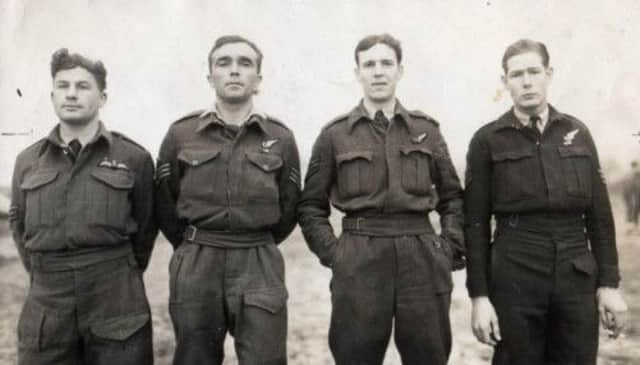WWII bomber crew laid to rest in Italy, 68 years on


The crew of the Royal Air Force Boston Bomber, which crashed just weeks before the end of the war, were buried with full military honours at the Padua War Cemetery in northern Italy, watched by their families.
Boston BZ590, from 18 Squadron Royal Air Force, took off from Forli, near Rimini, at 8.45pm on April 21 1945, targeting a river crossing on the Po at Taglio di Po followed by an armed reconnaissance of the Po Valley.
Advertisement
Hide AdAdvertisement
Hide AdBut it was brought down by anti-aircraft fire and the four-man crew, all aged 20 and 21, died.
They were pilot Sergeant David Raikes; navigator Flight Sergeant David Perkins; wireless operator and air gunner Flight Sergeant Alexander Bostock, all 20 and from the RAF Volunteer Reserve, as well as Australian air gunner Warrant Officer John Hunt, 21, from the Royal Australian Air Force.
The remains of the aircraft were unearthed in 2011 by Italian amateur archaeological society Archeologi dell’Aria, which searches for remains of Second World War aircraft.
Today relatives of three of the men travelled to Italy to see their remains finally laid to rest, coming from as far afield as New South Wales in Australia.
Sgt Raikes’ nephew, also called David, read a poem penned by his uncle at the service while Sgt Raikes’ brothers Roger and Tim Raikes travelled from Brecon in Wales for the occasion.
Tim Raikes, 79, said he only saw his brother once during the war when he came home in 1943 and read him to sleep.
“He was a big kind older brother to me, he was fun-loving,” he said.
Describing the day he learned of his death, he said: “I was 11 and my mother and I were alone in the house, and the telegram came.
Advertisement
Hide AdAdvertisement
Hide Ad“My mother opened it and passed it to me. My father was at work and she said ‘he will have one more day without knowing this. I can’t tell him. Put it on the mantlepiece and when he comes home, show him’.
“So I was left all day with this task hanging over me and that’s what I did and it’s a day I’ve never forgotten. The news was devastating. My parents were different people at the end of the war.
“I’ve been waiting all these years and thought he would never be found. We had to come here, see the crash site and to meet the other relatives and the warmth of the people has been marvellous. There are so many emotions, it was a joy to hear that his plane had been found.”
Relatives of Flt Sgt Perkins, originally from Honor Oak in south east London, were unable to attend the service, but the family of Warrant Officer Hunt travelled from the Shoalhaven region of New South Wales, Australia.
Glenice Hoffman, cousin to Flt Sgt Bostock, originally from Kimberley, Nottinghamshire, travelled with husband Raf from Forest Row in Sussex for the occasion.
She said: “My memory is seeing the heartache that his mother was living through and did live through for the rest of her life.
“Not knowing where her son was and getting the news that her 20 year old had disappeared, believed to be dead in the last few weeks of the war while everyone else was euphoric that it was finished, was tragic.
“For me, being the only surviving relative, hearing so much about him all my life, it’s a privilege and an honour to be here to bring some peace.”
Advertisement
Hide AdAdvertisement
Hide AdThe day before the service, the families visited a museum in Felonica which houses a display dedicated to Boston BZ590.
Fabio Raimondi, who led the team that excavated the crash site, presented Warrant Officer Hunt’s family with his watch, inscribed with his name and service number.
The ring of Flt Sgt Perkins, which was also recovered, is to be returned to his family who were unable to attend, officials said.
Personnel from the RAF’s 18 Squadron, who now operate the Chinook helicopter at RAF Odiham in Hampshire, also attended.
Officer Commanding 18(B) Squadron, Wing Commander Lee Turner, said: “It is a privilege to pay our respects to our colleagues and remember the ultimate sacrifice that the crew made for their country.
“Just as then, 18(B) Sqn personnel are currently serving on operations; this time in Afghanistan and the connection with our forebears remains strong. As a squadron we remember them.”
The burial was also attended by members of the British Embassy’s Navy and Air Attache, Royal Australian Air Force representatives, members of Archeologi dell’Aria, and Simone Guidorzi, director and curator of The North Apennines Po Valley Park.
Wing Commander Wes Perrett, from the Australian Department of Defence, said: “Australia has 1,100 crew that are still missing from World War Two and when we do identify a lost crew member, find out what happened to them and where they ended up, together with reaching out to the next of kin, is very special.
“It’s a great privilege to share the emotional rollercoaster with the family. The ceremony is the opportunity to bury the crew together as one, as they served together and died together.”